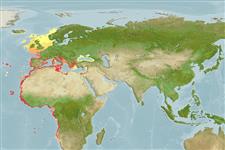Common names from other countries
Environment: milieu / climate zone / depth range / distribution range
Ecología
marino demersal; rango de profundidad ? - 300 m (Ref. 2683). Subtropical; - 23°S
Eastern Atlantic: off northwestern Africa south to 23°S; also in the Mediterranean.
Length at first maturity / Tamaño / Peso / Age
Maturity: Lm 12.0 range ? - ? cm
Max length : 39.7 cm TL macho / no sexado; (Ref. 107756); common length : 15.0 cm TL macho / no sexado; (Ref. 3397)
Adults inhabit soft bottoms from the coastline to about 300 m depth, but rarely caught at depths greater than 200 m (Ref. 9537). They feed on small fish and crustaceans (Ref. 231).
Life cycle and mating behavior
Madurez | Reproducción | Puesta | Huevos | Fecundidad | Larva
Nielsen, J.G., 1990. Citharidae. p. 1025. In J.C. Quero, J.C. Hureau, C. Karrer, A. Post and L. Saldanha (eds.) Check-list of the fishes of the eastern tropical Atlantic (CLOFETA). JNICT, Lisbon; SEI, Paris; and UNESCO, Paris. Vol. 2. (Ref. 6500)
IUCN Red List Status (Ref. 130435)
CITES (Ref. 128078)
Not Evaluated
Threat to humans
Harmless
Human uses
Pesquerías: escaso valor comercial
Más información
ReferenciasAcuiculturaPerfil de acuiculturaRazasGenéticaElectrophoresesheritabilidadEnfermedadesProcesamientoMass conversion
Herramientas
Special reports
Download XML
Fuentes de Internet
Estimates based on models
Preferred temperature (Ref.
115969): 11.8 - 19.5, mean 15.2 (based on 256 cells).
Phylogenetic diversity index (Ref.
82804): PD
50 = 1.0156 [Uniqueness, from 0.5 = low to 2.0 = high].
Bayesian length-weight: a=0.00589 (0.00469 - 0.00740), b=3.07 (3.00 - 3.14), in cm Total Length, based on LWR estimates for this species (Ref.
93245).
Nivel trófico (Ref.
69278): 4.0 ±0.65 se; based on food items.
Resiliencia (Ref.
120179): Medio, población duplicada en un tiempo mínimo de 1.4-4.4 años (K=0.26-0.30).
Fishing Vulnerability (Ref.
59153): Moderate vulnerability (37 of 100).
Climate Vulnerability (Ref.
125649): Low vulnerability (7 of 100).
